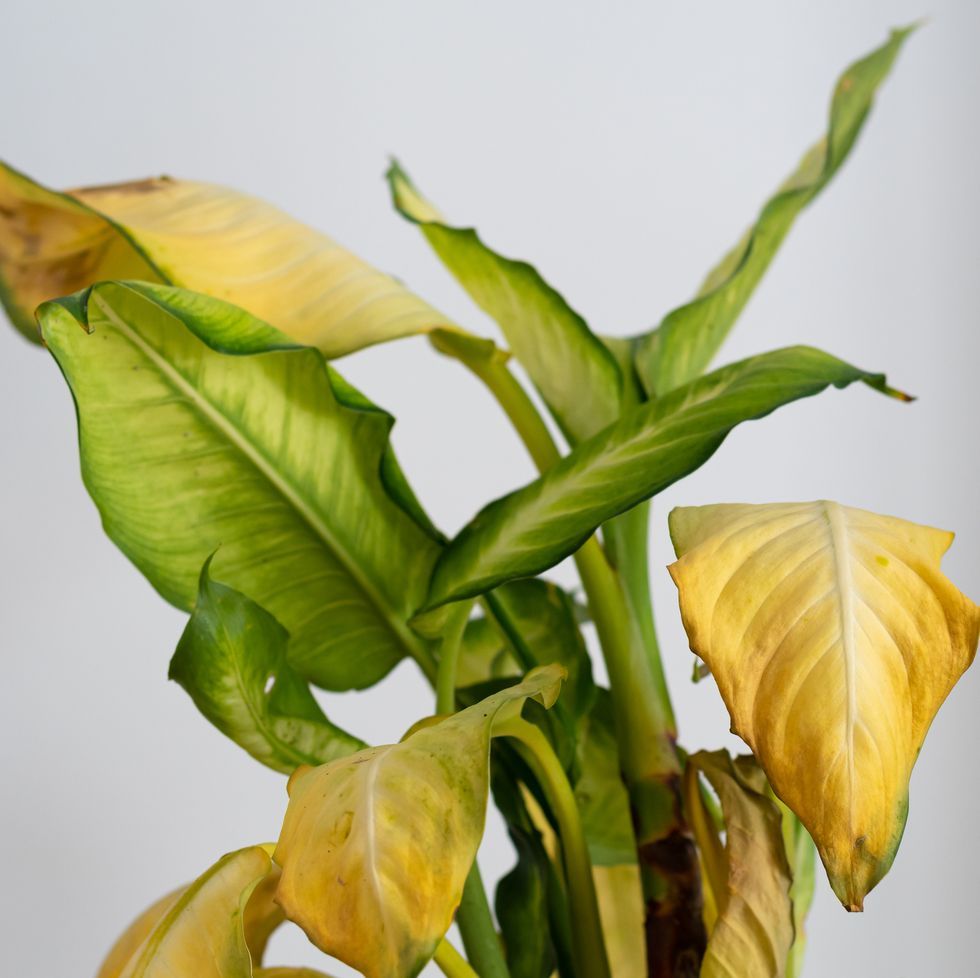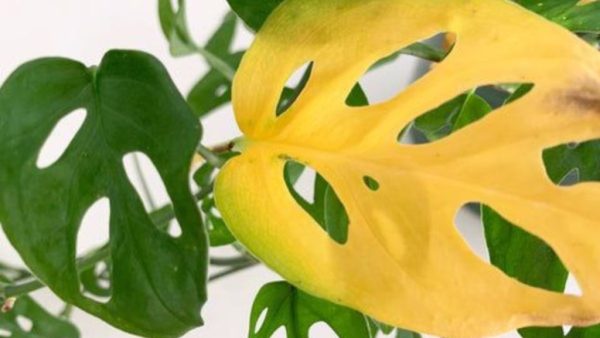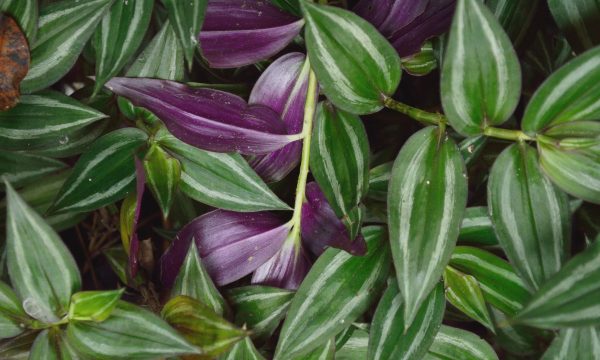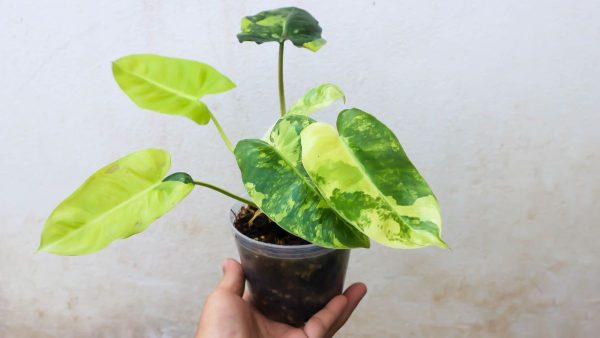Houseplants add a touch of nature to our homes, but sometimes their leaves can turn yellow, leaving us anxious.
So, in this article, I’ll share 7 common reasons why the leaves of your houseplants can turn yellow.
Let’s begin!
7 Reasons Houseplant Leaves Turn Yellow

1. Overwatering

When plants receive more water than they need, their roots can become waterlogged, inhibiting their ability to absorb oxygen effectively.
This often leads to a condition known as root rot, which can severely damage or kill the plant.
Yellowing of leaves in this scenario typically starts at the lower leaves and progresses upward as the condition worsens.
So, you should ensure that your plant’s pot has adequate drainage and that the soil is not constantly wet.
To check if overwatering is the issue, feel the soil; if it is soggy, you might be giving your plant too much water.
The presence of a musty smell or black, mushy roots upon inspection also indicates overwatering.
Fix
Allow the top inch of the soil to dry out before watering again.
Check the pot’s drainage, and improve it by adding holes or using a more porous soil mix.
If root rot has set in, remove the affected roots and repot the plant in fresh soil.
So, for ongoing care, instead of watering on a fixed schedule, water your plants based on need.
Stick your finger into the soil; if the top inch is dry, it’s time to water; this method helps prevent overwatering.
2. Underwatering
When plants don’t receive enough water, the lack of moisture leads to a decrease in the plant’s ability to perform photosynthesis effectively, resulting in yellow leaves.
This problem is particularly acute in environments where evaporation rates are high, such as in warm temperatures or low humidity conditions.
The soil tends to dry out quickly under these conditions, exacerbating the stress on the plant.
One clear indicator of underwatering is when the soil feels dry to the touch, and the plant shows signs of wilting.
Fix
You can make a regular watering schedule that keeps the soil consistently moist but not waterlogged.
Each houseplant has different moisture needs, so, you should adjust your watering routine based on the specific needs of your houseplants.
A good rule of thumb is to check the top inch of soil; if it feels dry, it’s time to water the plant.
3. Lighting

Lighting plays a crucial role in the health of houseplants and can often be a factor when leaves start turning yellow.
Both too much and too little light can cause stress to your plants, leading to yellowing leaves.
When plants are exposed to excessive light, particularly direct sunlight, it can “bleach” the leaves, causing them to lose their vibrant colors and turn yellow.
This is often noticeable in plants that are placed in very bright areas, such as near south-facing windows, where the intense light can scorch the leaves.
Conversely, not enough light can also lead to problems. Plants that are starved of adequate light tend to have weak, yellow leaves.
This is because the lack of light limits their ability to perform photosynthesis, which is crucial for their growth and health.
Typical signs include pale leaves and stunted growth, as the plant struggles to absorb enough light.
Fix
Firstly, you should determine how much natural light your plant needs. Research or refer to care instructions for your specific type of plant.
Next, you’ve to move plants that require more light closer to windows or into brighter areas.
For those that need less intense light, you can position them in partial shade, away from direct sunlight.
An east-facing window often provides a good balance of morning sunlight and afternoon shade.
If natural light is insufficient, especially during the winter months, consider using grow lights.
These special lights provide a spectrum of light that mimics natural sunlight, helping to boost plant health and prevent yellowing.
Rotating your plants occasionally ensures that all sides of the plant receive equal exposure to light.
4. Nutrient Deficiencies
Nutrient deficiencies prevent the plants from functioning properly and looking their best.
Common deficiencies include nitrogen, potassium, calcium, magnesium, and iron, each presenting with unique symptoms:
- Nitrogen deficiency typically shows as a general yellowing of older leaves, progressing to younger leaves as the condition worsens.
- Potassium deficiency is indicated by yellowing leaf edges and tips, sometimes accompanied by browning and wilting of older leaves.
- Calcium deficiency can result in pale or malformed new growth, and in fruiting plants, may affect the development of fruits.
- Magnesium deficiency manifests as a fading or lightening of older leaves, particularly between the veins, while the veins remain dark green.
- Iron deficiency (chlorosis) is noticeable as yellowing between the leaf veins, primarily in newer growth.
To identify which nutrient your plant may be lacking, you can observe the specific symptoms and conduct a soil test.
Soil tests provide insights into the nutrient content and pH level of your soil, allowing you to address specific deficiencies.
Fix
Once you’ve identified a potential nutrient deficiency, the following solutions can help restore your plant’s health:
1. Balanced Fertilization: Use a balanced, all-purpose fertilizer that suits the specific needs of your houseplant. Follow the package instructions for the correct dosage and frequency.
2. Organic Options: If you prefer natural remedies, you should consider using compost, worm castings, or fish emulsion. These organic fertilizers release nutrients slowly and improve soil health over time.
3. Specific Supplements: For targeted deficiencies, like iron, you should use specific supplements. Chelated iron is particularly effective for plants that show signs of iron deficiency.
4. Soil pH Adjustment: Some nutrients are only available to plants at certain pH levels. Adjusting your soil pH, either making it more acidic or more alkaline, can help increase nutrient availability. You may need to add lime to raise the pH or sulfur to lower it.
5. Foliar Feeding: This involves spraying a diluted nutrient solution directly onto the leaves, which can be an effective, quick fix for nutrient uptake, especially when root systems might be compromised.
5. Pests

Pests often cause damage before you even notice anything is amiss. Common pests like spider mites, aphids, and whiteflies sap nutrients directly from the leaves, leading to discoloration.
These tiny creatures are notorious for their rapid reproduction and can quickly colonize a plant, leaving behind telltale signs of infestation such as yellow pinpricks or general yellowing of the leaves.
Other less visible pests, like thrips and scale insects, can also wreak havoc on your plants.
They typically leave behind a sticky residue known as honeydew, which can attract further unwanted guests like ants and can foster the growth of sooty mold.
Over time, the affected leaves may turn yellow, wilt, and drop prematurely. It’s crucial to check your plants regularly for these pests.
Fix
You should regularly inspect your plants for signs of pests. Look for sticky residues, webbing, or the insects themselves.
Use a magnifying glass if needed to spot tiny pests like spider mites.
If you detect pests, isolate the affected plant immediately to prevent the spread to other houseplants.
Also, consider using natural remedies first, such as neem oil or insecticidal soap. These options are effective against most common pests and are safer for your plants and indoor air quality compared to chemical pesticides.
For minor infestations, physically removing pests can be effective. Wipe the leaves with a damp cloth or use a gentle stream of water to dislodge pests.
If the infestation is severe, you might need to resort to chemical pesticides.
6. Plant Diseases
On the other hand, houseplant yellow leaves can be caused by various pathogens, including fungi and bacteria.
These are a few diseases causing yellow leaves:
1. Anthracnose
This disease is marked by yellowing leaf tips that eventually turn tan and then dark brown.
The fungus responsible, such as Colletotrichum and Gloeosporium, can cause leaves to die back progressively.
2. Leaf Spots
This condition manifests as spots of different colors—brown, black, red, yellow, or tan—on the leaves.
These spots, which may display a concentric ring pattern, can cause the leaves to drop off or become distorted.
3. Powdery Mildew
Identified by white, powdery circles on leaves, this fungal infection thrives in cool indoor temperatures and high humidity, typically seen in the winter months.
4. Root and Stem Rot
Symptoms include mushy, black roots, wilting foliage, and browning or blackening stems.
These symptoms arise from fungi like Rhizoctonia and Pythium, which thrive in overly moist soil conditions.
5. Gray Mold (Botrytis Blight)
This disease features grayish bull’s-eye patterns on older foliage and thick, gray mold on dead plant debris.
It usually occurs in humid conditions with inadequate air circulation.
Fix
To overcome and prevent these diseases, consider the following strategies:
You should ensure good air circulation to prevent fungal diseases, such as powdery mildew and gray mold.
Overwatering is a common cause of root rot and other fungal diseases. Allow the soil to dry out between waterings and ensure pots have adequate drainage.
For diseases like anthracnose and leaf spots, apply fungicides. Common fungicides include chlorothalonil, myclobutanil, and tebuconazole.
Promptly remove and dispose of diseased plant material to prevent the spread of pathogens.
When repotting, using pasteurized or sterilized soil and clean pots can help avoid introducing new pathogens.
7. Aging
As houseplants age, it’s common for their older leaves to turn yellow and eventually drop off.
This natural aging process is part of the plant’s lifecycle, especially noticeable in perennial plants.
The yellowing occurs because, over time, these older leaves become less efficient at photosynthesis and the plant reallocates its resources to newer, more efficient leaves.
This is a regular part of the plant’s growth cycle, where it sheds older leaves to make way for new growth, particularly in the spring.
Yellowing can also indicate a slowdown in the plant’s overall growth activity, often seen during the colder months when many plants enter a dormant phase.
During this time, the plant’s nutritional needs decrease, and it may not require as much water or nutrients as during its active growing season.

